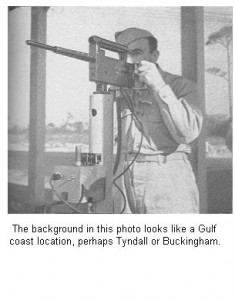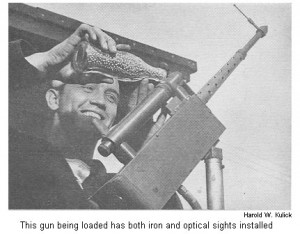Since no comprehensive description of the use of the MacGlashan guns has been found, what follows has perforce been compiled from a number of sources, each of which contributed a small portion of the overall picture.
The Army Air Forces most likely had E-3 ranges at all its flexible gunnery schools. AAF gunnery schools were located at Las Vegas NV, Harlingen TX, Tyndall Field at Panama City FL, Buckingham Field at Fort Myers FL, Laredo TX, Kingman AZ, and Yuma AZ. By the end of August 1944 these schools had turned out some 214,826 gunners (many of whom had other primary duties, such as bombardier, navigator, flight engineer, radioman, etc.).
At Tyndall, the targets moved at 400 ft. per min. These targets were scaled to simulate ranges of 200, 400, and 600 yards, but the scale factor is unknown.
The backdrops tended to be heavy fabric, both to absorb the BB’s energy and minimize ricochets. There was no method of scoring or recording aiming errors. Although a project was initiated to provide scoreable targets, the outcome is unknown. It has been said that at Las Vegas gunnery students were encouraged to use these ranges in their free time (Steinbeck), so they may have been recreational rather than an integral part of the course curriculum, but this may have varied from school to school. This view may be substantiated by the fact that two scholarly studies* of flexible gunnery training make no mention of the BB machine gun in their discussion of training devices.
*Flexible Gunnery Training in the AAF, Henry H. Simms, Assistant Chief of Air Staff, Intelligence, Historical Division, March, 1945.
Psychological Research on Flexible Gunnery Training, Army Air Forces Aviation Psychology Program Research Report No. 11, 1947
The Navy needed far fewer aerial gunners than the AAF, since most Naval aircraft other than patrol bombers carried but one gunner, whereas Air Forces heavy bombers had six or more, and medium bombers at least three.The Navy’s aerial gunners were trained at the Naval Air Gunnery Schools at Hollywood, Jacksonville, Melbourne, Miami, and Pensacola FL, Purcell OK, Kaneohe HI, Norfolk VA, Fallon NV and Whidbey Island WA.
At the Naval Air Gunnery School at Jacksonville there was a outdoor air machine gun range having a dozen gun positions along its firing line. Paper targets moved along a horizontal endless belt . The use of paper targets enabled scoring and a record of aiming errors.
There is evidence that the Navy took the BB machine gun more seriously than the AAF, and that the BB range was an integral part of the training course, at least through 1943.
The light and dark areas of the backstop probably defined an area to start tracking and establish the correct lead, a central firing area, and an area to receive the final BBs of the last burst.
The outdoor range afforded a greater firing distance than the indoor ranges. Although no definite specification has yet been found, several clues point to a range distance of 1,000 inches (83.3 feet). This installation was probably typical of all the NAGS.
By the summer of 1944 the BB machine guns had been phased out of both the Navy and AAF gunnery training programs. Not only were machine guns and ammunition for them plentiful by that time, but also it was concluded that the BB guns did not relate directly to the skills required of aerial gunners.
The final type of installation, for the use of AAF fighter pilot trainees during their 10-week course at advanced flying schools, was a fixed gunnery trainer (fixed in the sense that the gun was rigidly attached to the airplane). This device, developed by Major James E. Haile at Eglin Field, went through several development stages. The first, known as the BB Link trainer, or Link Fixed Gunnery Range, consisted of as many as three standard Link trainers with a BB machine gun mounted atop the cowling. Photographs of the BB Link are not clear enough to identify the gun — it may have been an Edison electric gun; if a MacGlashan the magazine has been radically redesigned. The student “flew” the Link trainer so as to aim at a target that ran around on a closed-loop track, using a standard N-3A reflector gunsight. As the target moved around the track it presented different aspect angles, requiring different lead angles to be estimated. The target consisted of an array of paper silhouettes of enemy aircraft or tow-target sleeves, arranged one above the other. Each student would be assigned one of the targets, at which he could fire one hundred rounds. His percentage score was the number of holes in his target. The speed, size and range of the target were all at a scale of 1:30, with scaled target speeds of 200, 250 or 300 mph available. The cyclic rate of the gun was 600 rounds per minute.

This served to prove the concept, and resulted in a production model designated the Fixed Gunnery Trainer Type E-12. It consisted of a simplified (and therefore cheaper) Link trainer-like cockpit with the gun mounted internally in the nose. A small rectangular target (presumably scoreable) was now mounted on a trolley that ran back and forth along an outdoor track shaped so as to simulate the ideal pursuit curve attack for AT-6 fixed gunnery, and provide training in range estimation, alignment, deflection allowance and coordination of trigger finger reaction to the correct sight picture. The E-12 installation usually included two tracks going in opposite directions, so that several trainers could operate simultaneously. The tracks were about 320 feet long, and the maximum range was about 250 feet (corresponding to a substantial gravity drop for a BB). This trainer could probably have been found at advanced single-engine flying schools, most of which were located in the southwest (e.g., Eagle Pass, TX). Since a typical installation consisted of four trainers, it appears that the E-13 gun saw service at about 53 locations.

An indoor installation of an E-12, at the AAF School of Applied Tactics at Orlando, is shown below. Here a model airplane was used that had no provision for scoring, other than perhaps the satisfying sound of the BB striking the model when hits were scored.

The first 152 of the E-12 trainers carried the E-3 gun, with the trigger switch parallel-wired to a trigger switch on the student’s control column. Although no evidence has been found, it seems probable that URs (Unsatisfactory Reports) started streaming in regarding the difficulty of filling and emptying the magazine of the E-3 as installed in the trainer. First, access to the gun required removing the cowling of the trainer. Second, since the gun was rigidly attached to the trainer, it could not be tipped up to insure that the magazine was fully filled with BBs, and finally, for the same reason, it is quite probable that not all the BBs in the magazine entered the loading ratchet and were fired.
The answer to these problems was the E-13 gun, in which the magazine was vertical and protruded through the cowling so that it was readily accessible for loading. Being vertical, it was easy to fully fill, and gravity insured that the entire contents was consumed. Also, it omitted the grips and trigger at the rear of the receiver, which were no longer needed. When the E-13 gun went into production and became available, it was installed in the remaining 212 E-12 trainers. It is not known whether any of the early trainers were retrofitted.
The E-12, which was manufactured by the Sparks-Withington Corporation (aka Sparton) of Jackson, Michigan, had a relatively short life, being declared standard on May 14, 1943 and obsolete on December 26, 1944, well before the end of the war. This was probably due to the fact that the pursuit curve attack was employed less and less as the war progressed and fighter missions increasingly consisted of bomber escort, which involved fighter vs fighter tactics. Training for this sort of gunnery was better provided by more advanced devices such as the Gunairstructor









